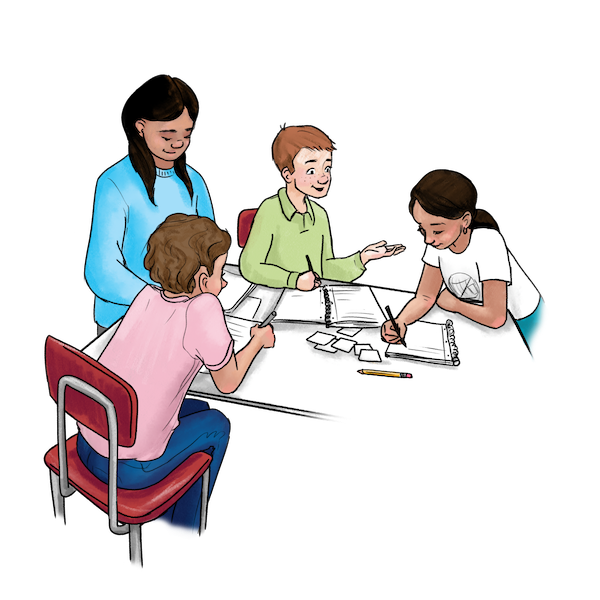
In moving to a new city and new school, I, Michelle Lo, found myself teaching a different population of students than I had in my previous years of teaching. Where I am located in Los Angeles, my school has a higher-than-average percentage of students who are new to the country.
I am a member of CPM’s Teacher Research Corps, a group of teachers who conduct action research in their classes. I did research with TRC 8.0 with Cathy Sinnen (2021) that I wanted to build on in my new research project, but I wanted to focus on multilingual students. The goals and objectives for this project include:
- building scaffolding strategies and routines for mathematics and language learning;
- increasing verbal participation in whole-class or small-group discussions;
- learning what mathematical contexts are culturally relevant to students who are from Central and South America; and
- utilizing students’ language and background knowledge as assets in the classroom.
The intention for teaching language in a mathematics classroom is not for the purpose of assimilation. I believe that students who learn mathematics while speaking more than one language can improve their understanding of mathematics in dimensions monolinguals do not experience.
Also, although mathematics is often perceived as a “requirement” for college and career, I do not intend to sell my mathematics class as a hoop to jump through for the sake of college and career. In using CPM as a curriculum, I see how the additional support newcomer students need to engage with the materials and concepts goes beyond the beautifully translated Spanish version of the texts. This project was intended to change conversations about CPM’s curriculum and how it might further support newcomer students through additional narratives for chapters, routines teachers can use, and other considerations teachers might think about in their classrooms with newcomer students.
Lastly, my project is grounded in an asset-based framing towards my students and their ability to think for themselves. Instead of depending on the teacher to facilitate and validate students’ ideas, I believe that students have the ability to make sense of mathematics with each other, including the variety of ways to solve a problem.
The project focuses on one particular section of Algebra 1 because of its collection of newcomer students. While there is research showing that heterogeneous classes improve learning outcomes for everyone, due to resources, it was more helpful for the newcomer students to be placed in the same class. During the fall semester, all of the newcomer students and several monolingual or fluent bilingual Spanish-speaking students were in my third-period class. However, the size of the class increased to 32 students by the end of the semester, and the counselors decided to take out all of the non-newcomer students for the spring semester. So, during the spring semester, my third-period Algebra 1 class was all newcomer students. I decided to focus this project on the whole class. Although the students in this class have varying levels of English proficiency, I still find it helpful to focus on the entire class when thinking about support in language learning.
For this project in supporting students to increase participation, I have tried several different activities and interventions in my teaching. They include:
Here is what I have learned from using these activities and interventions with multilingual learners.
I found it difficult to differentiate instruction, given the varying levels of English fluency in the classroom. But once I had a roster change, I noticed that the newcomer students were noticeably more comfortable speaking in general and speaking in English in the homogeneous classroom than in the heterogeneous classroom. I had been skeptical, given the research that shows how heterogeneous classrooms are more beneficial for learning (Lotan & Cohen, 2014). In the homogeneous class, there is a lot more translanguaging happening between students and between the students and me.I am also finding that I am better able to provide intentional and meaningful language support, such as sentence frames, and to hold discussions about the English language.
Moreover, since I am also learning Spanish alongside the newcomer students learning English, I am modeling a “learner stance” for the students and showing my translanguaging between the two languages. I find that there is more laughter when students hear me stumbling through Spanish, as my vulnerability permits students also to make mistakes when speaking English. My lens on teaching multilingual learners is shifting toward cultivating and fostering joy. These students’ identity as language learners is not their only identity. Many also carry the identity of being new to the United States, often having experienced difficult circumstances and trauma before arriving in the U.S.
In my teaching, I have been increasing wait time when asking questions and always allowing students time to write their ideas down before sharing them with the class. I will continue to increase access and opportunities for students to share their ideas about mathematics as I implement these innovations for the remainder of the school year.
References
Chval, K. B., Smith, E., Marcela, T. C. L., & Pinnow, R. J. (2021). Teaching math to multilingual students: Positioning English learners for Success: Grades K-8. Corwin, a SAGE Company.
Lotan, R. A., Cohen, E. G. (2014). Designing Groupwork: Strategies for the Heterogeneous Classroom. United Kingdom: Teachers College Press.
Mendoza, J. (2023, January). The CPM Educational Newsletter. Retrieved February 10, 2023, from https://indd.adobe.com/view/publication/8e596c0f-8b07-418c-a893-6055ede0a15b/gr73/publication-web-resources/pdf/CPM_NL_Jan_2023.pdf
NCSM & TODOS (2021). Positioning Multilingual Learners for Success in Mathematics. https://www.todos-math.org/assets/images/NCSM-TODOS%20Multilingual%20Learners%20Position%20Paper%202021.pdf
Robertson, K. (n.d.). Math instruction for English language learners. Colorín Colorado. Retrieved February 10, 2023, from https://www.colorincolorado.org/article/mathinstruction-english-language-learners
Rodríguez, L. A., Krause, G. H., & Adams-Corral, M. (2020). Flowing With the Translanguaging Corriente: Juntos Engaging With and Making Sense of Mathematics. Teaching for Excellence and Equity in Mathematics, 11(2), 17–24.
Zwiers, J., Dieckmann, J., Rutherford-Quach, S., Daro, V., Skarin, R., Weiss, S., & Malamut, J. (2017). Principles for the Design of Mathematics Curricula: Promoting Language and Content Development. Retrieved from Stanford University,
UL/SCALE website: http://ell.stanford.edu/content/ mathematics-resources-additional-resources
